According to a report by the Associated Press, the Chinese are planning to put humans on the Moon by 2020. If everything goes as planned, the Chinese will probably launch a probe to orbit the Moon in 2007, and land a spacecraft there in 2010. Since their first launch of a human in October 2003, China has been much more forthcoming about their spaceflight plans. Earlier this month China said that they will probably launch their next Shenzhou flight within two years, potentially carrying two humans into space.
Japanese Rocket Destroyed Shortly After Launch
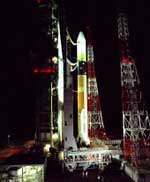
Image credit: JAXA
The Japanese space program suffered a setback on Saturday when a booster failed to detach from an H2-A rocket. Operators forced the rocket to self destruct, as it wouldn’t be able to reach its intended orbit with the additional weight of the booster. The rocket was carrying two spy satellites which were intended to keep an eye on North Korea’s rocket program. Prior to Saturday’s failure, the H2-A rocket had launched five consecutive times safely, but insurance companies will probably require six safe launches before covering commercial launches.
The Japan Aerospace Exploration Agency (JAXA) launched the H-IIA Launch Vehicle No 6 (H-IIA F6) with the information gathering satellite #2 (IGS) onboard from the Tanegashima Space Center at 13:33 on November 29, 2003 (Japan Standard Time). However, the vehicle failed to jettison one of its two Solid Rocket Boosters (SRB-As). H-IIA F6 was consequently destroyed by a destruction command from the ground at 13:43:53 as the vehicle did not gain enough height and speed due to the failure.
JAXA has established an accident investigation team led by President Yamanouchi and is investigating the cause of the accident. JAXA will provide additional information when it becomes available.
Evidence for Planets Around Vega
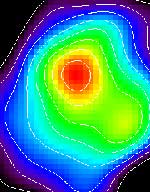
Image credit: PPARC
Astronomers from the Particle Physics and Astronomy Research Council believe they’ve discovered a planetary system around Vega, one of the brightest stars in the sky. Not only that, the star system seems remarkably similar to our own Solar System. So far, they’ve found evidence for a Neptune-sized planet in the same orbit as our own Neptune. This means there could be smaller, rocky planets closer in to the star.
Astronomers at the Particle Physics and Astronomy Research Councils UK Astronomy Technology Centre (ATC) at the Royal Observatory, Edinburgh have produced compelling new evidence that Vega, one of the brightest stars in the sky, has a planetary system around it which is more like our own Solar System than any other so far discovered.
All of the hundred or so planets that have been discovered around other stars have been very large gaseous (Jupiter-like) planets orbiting close to their star. This is very unlike our own Solar System. New computer modelling techniques have shown that observations of the structure of a faint dust disk around Vega can be best explained by a Neptune-like planet orbiting at a similar distance to Neptune in our own solar system and having similar mass. The wide orbit of the Neptune-like planet means that there is plenty of room inside it for small rocky planets similar to the Earth the Holy Grail for astronomers wanting to know whether we are alone in the Universe.
The modelling, which is described today (1 December 2003) in The Astrophysical Journal, is based on observations taken with the world’s most sensitive submillimetre camera, SCUBA. The camera, built at the ATC, is operated on the James Clerk Maxwell Telescope in Hawaii. The SCUBA image shows a disk of very cold dust (-180 degrees centigrade) in orbit around the star.
The irregular shape of the disk is the clue that it is likely to contain planets explains astronomer Mark Wyatt, the author of the paper. Although we cant directly observe the planets, they have created clumps in the disk of dust around the star.
The modelling suggests that the Neptune-like planet actually formed much closer to the star than its current position. As it moved out to its current wide orbit over about 56 million years, many comets were swept out with it, causing the dust disk to be clumpy.
Exactly the same process is thought to have happened in our Solar System, said Wyatt, Neptune was pushed away from the Sun because of the presence of Jupiter orbiting inside it. So it appears that as well as having a Neptune-like planet, Vega may also have a more massive Jupiter-like planet in a smaller orbit.
The model can be tested in two ways as Wayne Holland, who made the original observations, explains The model predicts that the clumps in the disk will rotate around the star once every three hundred years. If we take more observations after a gap of a few years we should see the movement of the clumps. Also the model predicts the finer detail of the disks clumpiness which can be confirmed using the next generation of telescopes and cameras.
Paradoxically the star barely appears in the SCUBA image because it is far too hot to be seen with this kind of detector. Vega is, however, easily seen with the naked eye. It is the third brightest star visible from Northern latitudes and is bluish-white in colour. Tonight you can see it in the west at around 7pm.
Facts about Vega
* Vega is the fifth brightest star in the sky and the third brightest visible in the Northern hemisphere.
* It is 25 light years away from the Sun (1AU is the distance between the Earth and Sun).
* It has a diameter three times bigger than the Sun.
* It is 58 times brighter than the Sun.
* Together with Deneb and Altair, Vega forms the summer triangle.
* Vega is the brightest star in the constellation Lyra, the Harp. The lyre, or harp, is supposed to have been invented by the Greek God Hermes who gave it to his half-brother Apollo. Apollo then gave it to his son Orpheus, the musician of the Argonaughts.
* Vega was the first star ever to be photographed. During the night of July 16-17 1850 the historic picture was taken at Harvard Observatory using a 15 inch refractor telescope during a 100 second exposure.
Original Source: PPARC News Release
Neptune Emptied the Kuiper Belts
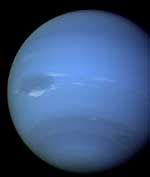
Image credit: NASA
Researchers from the Southwest Research Institute believe they have a theory that could help explain why there are so few objects in the Kuiper belt – a band of objects outside the orbit of Neptune. According to theories of how planetary systems form, there should be 100 times more material in the Kuiper belt than astronomers have observed. The researchers believe that the gas giants, including Neptune, formed closer to the Sun, and have slowly drifted further out over time. As Neptune migrated out, it could have pushed the Kuiper objects out of the solar system.
A new study by researchers at Southwest Research Institute (SwRI) and the Observatoire de la C?te d’Azur provides an explanation for one of the more mysterious aspects of the population of objects beyond Neptune. In doing so, it provides a unique glimpse into the proto-planetary disk from which the Solar System’s planets formed. Results will be published in the November 27 issue of Nature.
The Kuiper belt is a region of the Solar System that extends outward from Neptune’s orbit, containing billions of icy objects from kilometers to thousands of kilometers across. It was discovered in 1992 and, since that time nearly 1,000 objects have been cataloged. Some of these objects are very large – the largest having a diameter of more than 1,000 kilometers.
As astronomers have studied this structure, a mystery has unfolded. Like most of the planets in the Solar System, the large Kuiper belt objects are believed to have been formed from smaller objects that stuck together when they collided. For this process to have worked in the distant regions beyond Neptune, the Kuiper belt would have to contain more than 10 times the amount of material than is in the Earth. However, telescopic surveys of this region show that it currently contains roughly one-tenth the mass of the Earth, or less.
To solve the puzzle, researchers have been searching for several years for a way to remove more than 99 percent of the Kuiper belt’s material. However, Dr. Harold Levison (SwRI) and Dr. Alessandro Morbidelli (Observatoire de la C?te d’Azur of Nice, France) describe in their article, “Forming the Kuiper Belt by the Outerward Transport of Objects During Neptune’s Migration,” that the Kuiper belt may not have lost much mass at all.
“The mass depletion problem has been sticking in our throat for some time,” says Levison, a staff scientist in the SwRI Space Studies Department. “It looks like we may finally have a possible answer.”
Levison and Morbidelli argue that the proto-planetary disk from which the planets, asteroids and comets all formed had a heretofore unanticipated edge at the current location of Neptune, which is at 30 astronomical units (AU, the average distance between the Sun and Earth), and that the region now occupied by the Kuiper belt was empty. All the Kuiper belt objects we see beyond Neptune formed much closer to the Sun and were transported outward during the final stages of planet formation.
Researchers have known for 20 years that the orbits of the giant planets moved around as they formed. In particular, Uranus and Neptune formed closer to the Sun and migrated outward. Levison and Morbidelli show that Neptune could have pushed all the observed Kuiper belt objects outward as it migrated.
“We really didn’t solve the mass depletion problem, we circumvented it,” says Levison. “According to our work, the void beyond Neptune was probably devoid of objects.”
However, in this model, the region interior to 30 AU contained enough material for the Kuiper belt objects to form. The mechanisms employed by Neptune to push out the Kuiper belt only affected a small fraction of the objects. These became the objects seen by astronomers; the rest were scattered out of the Solar System by Neptune. This new theory explains many of the observable features of the outer Solar System, including the characteristics of the orbits of the Kuiper belt objects and the location of Neptune.
“One of the puzzling aspects of Neptune’s migration is why it stopped where it did,” says Morbidelli. “Our new model explains this as well. Neptune migrated until it hit the edge of the proto-planetary disk, at which point it abruptly stopped.”
NASA, the National Science Foundation and the Centre National de la Recherche Scientifique in Paris funded this research.
Original Source: SwRI News Release
Mars Odyssey Instrument Fails
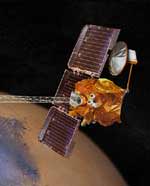
Image credit: NASA/JPL
During a recent solar storm, an instrument on board NASA’s Mars Odyssey spacecraft failed, and so far, operators haven’t been able to get it working again. The Martian Radiation Environment (MARIE) was designed to measure the radiation in the Martian space environment, which will help mission planners understand what kinds of risks humans might face if they traveled to the Red Planet. Operators will continue their attempts to get the instrument working for a few weeks before writing it off.
The martian radiation environment experiment on NASA?s 2001 Mars Odyssey orbiter has collected data continuously from the start of the Odyssey mapping mission in March 2002 until late last month. The instrument has successfully monitored space radiation to evaluate the risks to future Mars-bound astronauts. Its measurements are the first of their kind to be obtained during an interplanetary cruise and in orbit around another planet.
On Oct. 28, 2003, during a period of intense solar activity, the instrument stopped working properly. Controllers? efforts to restore the instrument to normal operations have not been successful. These efforts will continue for the next several weeks or months.
The martian radiation environment experiment detects energetic charged particles, including galactic cosmic rays and particles emitted by the Sun in coronal mass ejections. The dose equivalent from galactic cosmic rays as measured by the instrument agrees well with predictions based on modeling. Validation of radiation models is a crucial step in predicting radiation-related health risks for crews of future missions.
“Even if the instrument provides no additional data in the future, it has been a great success at characterizing the radiation environment that a crewed mission to Mars would need to anticipate,” said Dr. Jeffrey Plaut, project scientist for Mars Odyssey at NASA’s Jet Propulsion Laboratory, Pasadena, Calif.
JPL manages the Mars Odyssey and Global Surveyor missions for NASA’s Office of Space Science, Washington, D.C. Investigators at Arizona State University, Tempe; University of Arizona, Tucson; NASA’s Johnson Space Center, Houston; the Russian Aviation and Space Agency, Moscow; and Los Alamos National Laboratory, Los Alamos, N.M., built and operate Odyssey science instruments. Information about NASA’s Mars exploration program is available on the Internet at: http://mars.jpl.nasa.gov.
Original Source: NASA/JPL News Release
Astronauts Hear a Crunching Sound on the Station
Astronauts on board the International Space Station heard what sounded like a tin can being crushed against the outer hull, bringing up the possibility that there was some damage to the station. The sound might have been produced by equipment on the station, or it could have been space junk brushing against the hull. A spokesman for the Russian Space Agency said that all the systems on the station are working properly, and an outside inspection of the station didn’t show any damage.
Images of Wetlands from Space
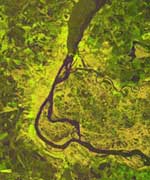
Image credit: ESA
The Earth’s wetlands are home to some of the most fragile and diverse ecosystems on the planet, and they’re under constant threat from human agriculture, pollution, and settlement. This month the European Space Agency began a program to map 50 wetland areas around the Earth from space to help keep track of their health. ESA’s Envisat is able to tell the difference between dry and waterlogged areas, and will be able to provide annual data about how various wetlands change throughout the seasons.
Dotted across varied regions of our planet are the waterlogged landscapes known as wetlands. Often inaccessible, these muddy areas are actually treasure houses of ecological diversity ? their overall value measured in trillions of Euros.
For much of the last century wetlands have been drained or otherwise degraded, but scientific understanding of their important roles in terms of biology and the water cycle has grown, spurring international efforts to preserve them. On 20 November ESA formally began a project to map wetlands from space, providing data on around 50 sites in 21 countries worldwide.
In 1971 an inter-governmental treaty established the Ramsar Convention on Wetlands, establishing a framework for the stewardship and preservation of wetlands. Today more than 1310 wetlands have been designated as Wetlands of International Importance, a total area of 111 million hectares. The Convention’s 138 national signatories are obliged to report on the state of listed wetlands they are responsible for.
ESA’s new ?1 million Globwetland project is producing satellite-derived and geo-referenced products including inventory maps and digital elevation models of wetlands and the surrounding catchment areas. These products will aid local and national authorities in fulfilling their Ramsar obligations, and should also function as a helpful tool for wetland managers and scientific researchers.
“The Ramsar Convention on Wetlands stresses that targeted assessment and monitoring information is vital for ensuring effective management planning for wetlands, their hydrology and their catchments,” explained Nick Davidson, Ramsar’s Deputy Secretary General. “Yet for wetland managers and decision-makers in many countries access to sound information about wetlands and how they are changing is often a critical gap.
“By working with users at site and catchment scales the Globwetland project should contribute significantly to helping achieve effective management of these critical important ecosystems for biodiversity and human well-being.”
With wetlands often made up of difficult and inaccessible terrain, satellites can help provide information on local topography, the types of wetland vegetation, land cover and use and the dynamics of the local water cycle. In particular radar imagery of the type provided by ESA’s Envisat is able to differentiate between dry and waterlogged surfaces, and so can provide multitemporal data on how given wetlands change seasonally.
Data gathered over four continents
Globwetland products are being provided for a wide range of terrain types to users across four continents: North and South America, Africa, Asia and Europe, including European Russia. In Spain the Globwetland end-user is the government’s Ministry of the Environment.
“We have previously used aerial photography to prepare wetland maps, but this is the first time we will use Earth Observation data,” said Jos? Ram?n Picatoste Ruggeroni, Director General of Nature Conservation and Subdirector General of Biodiversity Conservation. “The areas we are most interested in are land cover and land cover analysis, topography dynamics and subsidence layers, water cycle and quality maps.
“In co-operation with the Spanish regional authorities involved in nature conservation and local wetland managers, we hope to investigate the possibility of achieving a common standard of regularly updated geoinformation to monitor ecological changes in the Spanish Ramsar sites.”
At the other side of the continent, wetlands comprise a third of the territory of the Russian Federation, the majority of it in the form of peatlands. Through much of the 20th century these areas were regarded as wasteland and drained for peat extraction – ending up as unproductive lands that do not contribute either economically or in terms of biodiversity, and also cause ecological problems such as dust storms and uncontrolled carbon dioxide emissions from smouldering peat fires.
In Russia the Globwetland partner is the Ministry of Ecology and Land Use of Moscow region, and has a particular interest in using periodic satellite data to monitor peat fires and estimate how effective a new rewetting project is in preventing further outbreaks.
While in South Africa, Globwetland partner the Department of Environmental Affairs and Tourism (DEAT) seeks to use satellite data to help fulfil its Ramsar obligations for its existing three-site wetlands inventory. The Department also plans to map a separate site, the Prince Edward Islands Special Nature Reserve, for the first time.
South Africa hopes to propose the offshore Reserve for designation as a new Ramsar Wetland of International Importance, but its uncharted nature is currently an obstacle to achieving this. This Southern Ocean site is also being nominated next year as a UNESCO World Heritage Site.
Why are wetlands so valuable?
Studies of wetlands show they store and purify water for domestic use, recharge natural aquifers as they run low, retain nutrients in floodplains, help control flooding and shore erosion and regulate local climate.
Most of all, wetlands support life in spectacular variety and numbers: freshwater wetlands alone are home to four in ten of all the world’s species, and one in eight of global animal species.
An assessment of the monetary value of natural ecosystems published in Nature in 1997 arrived at a figure of 27.7 trillion Euros (33 trillion dollars), with wetland ecosystems making up ?12.5 trillion ($14.9 trillion) ? or 45% – of this total.
Much of human civilisation has been based around river valleys and floodplains. However, global freshwater consumption rose sixfold during the 20th century, a rate more than double that of population growth. And world population is set to rise by 70 million people a year for the next two decades.
Couple that trend with the threat of accelerating climate change, and biologically-productive and hydrologically-stabilising wetlands look like necessities we can ill do without.
Original Source: ESA News Release
The Next Supernova?
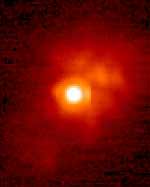
Image credit: ESO
The European Southern Observatory has released new images of a relatively nearby star, Eta Carina, which could be in the final stages of its life and could explode as a supernova in the near future (astronomically-speaking) – within the next 10-20,000 years or so. The star is 7,500 light years away, 100 times the mass of the Sun, and the most luminous object in the Milky Way. Since 1841, it has created a beautiful nebula around itself by continuously shedding outside layers while it spins quickly. By watching how Eta Carina changes, astronomers will gain valuable insights into the final stages of a supermassive star’s life.
Ever since 1841, when the until then inconspicuous southern star Eta Carinae underwent a spectacular outburst, astronomers have wondered what exactly is going on in this unstable giant star. However, due to its considerable distance – 7,500 light-years – details of the star itself were beyond observation.
This star is known to be surrounded by the Homunculus Nebula, two mushroom-shaped clouds ejected by the star, each of which is hundreds of times larger than our solar system.
Now, for the first time, infrared interferometry with the VINCI instrument on ESO’s Very Large Telescope Interferometer (VLTI) enabled an international team of astronomers [1] to zoom-in on the inner part of its stellar wind. For Roy van Boekel, leader of the team, these results indicate that “the wind of Eta Carinae turns out to be extremely elongated and the star itself is highly unstable because of its fast rotation.”
A monster in the southern sky
Eta Carinae, the most luminous star known in our Galaxy, is by all standards a real monster: it is 100 times more massive than our Sun and 5 million times as luminous. This star has now entered the final stage of its life and is highly unstable. It undergoes giant outbursts from time to time; one of the most recent happened in 1841 and created the beautiful bipolar nebula known as the Homunculus Nebula (see ESO PR Photo 32a/03). At that time, and despite the comparatively large distance – 7,500 light-years – Eta Carinae briefly became the second brightest star in the night sky, surpassed only by Sirius.
Eta Carinae is so big that, if placed in our solar system, it would extend beyond the orbit of Jupiter. This large size, though, is somewhat arbitrary. Its outer layers are continually being blown into space by radiation pressure – the impact of photons on atoms of gas. Many stars, including our Sun, lose mass because of such “stellar winds”, but in the case of Eta Carinae, the resulting mass loss is enormous (about 500 Earth-masses a year) and it is difficult to define the border between the outer layers of the star and the surrounding stellar wind region.
Now, VINCI and NAOS-CONICA, two infrared-sensitive instuments on ESO’s Very Large Telescope (VLT) at the Paranal Observatory (Chile), have probed the shape of the stellar wind region for the first time. Looking down into the stellar wind as far as possible, the astronomers could infer some of the structure of this enigmatic object.
The astronomer team [1] first used the NAOS-CONICA adaptive optics camera [2], attached to the 8.2-m VLT YEPUN telescope, to image the hazy surroundings of Eta Carinae, with a spatial resolution comparable to the size of the solar system, cf. PR Photo 32a/03.
This image shows that the central region of the Homunculus nebula is dominated by an object that is seen as a point-like light source with many luminous “blobs” in the immediate vicinity.
Towards the limit
In order to obtain an even sharper view, the astronomers then turned to interferometry. This technique combines two or more telescopes to achieve an angular resolution [3] equal to that of a telescope as large as the separation of the individual telescopes (cf. ESO PR 06/01 and ESO PR 23/01).
For the study of the rather bright star Eta Carinae the full power of the 8.2-m VLT telescopes is not required. The astronomers thus used VINCI, the VLT INterferometer Commissioning Instrument [4], together with two 35-cm siderostat test telescopes that served to obtain “First Light” with the VLT Interferometer in March 2001 (see ESO PR 06/01).
The siderostats were placed at selected positions on the VLT Observing Platform at the top of Paranal to provide different configurations and a maximum baseline of 62 meters. During several nights, the two small telescopes were pointed towards Eta Carinae and the two light beams were directed towards a common focus in the VINCI test instrument in the centrally located VLT Interferometric Laboratory. It was then possible to measure the angular size of the star (as seen in the sky) in different directions.
Pushing the spatial resolution of this configuration to the limit, the astronomers succeeded in resolving the shape of the outer layer of Eta Carinae. They were able to provide spatial information on a scale of 0.005 arcsec, that is about 11 AU (1650 million km) at the distance of Eta Carinae, corresponding to the full size of the orbit of Jupiter.
Scaled down to terrestial dimensions, this achievement compares to making the distinction between an egg and a billiard ball at a distance of 2,000 kilometers.
A most unusual shape
The VLTI observations brought the astronomers a surprise. They indicate that the wind around Eta Carinae is amazingly elongated: one axis is one-and-a-half times longer than the other! Moreover, the longer axis is found to be aligned with the direction in which the much larger mushroom-shaped clouds (seen on less sharp images) were ejected.
Spanning a scale from 10 to 20-30,000 AU, the star itself and the Homunculus Nebula are thus closely aligned in space.
VINCI was able to detect the boundary where the stellar wind from Eta Carinae becomes so dense that it is no longer transparent. Apparently, this stellar wind is much stronger in the direction of the long axis than of the short axis.
According to mainstream theories, stars lose most mass around their equator. This is because this is where the stellar wind gets “lifting” assistance from the centrifugal force caused by the star’s rotation. However, if this were so in the case of Eta Carinae, the axis of rotation (through the star’s poles) would then be perpendicular to both mushroom-shaped clouds. But it is virtually impossible that the mushroom clouds are positioned like spokes in a wheel, relative to the rotating star. The matter ejected in 1841 would then have been stretched into a ring or torus.
For Roy van Boekel, “the current overall picture only makes sense if the stellar wind of Eta Carinae is elongated in the direction of its poles. This is a surprising reversal of the usual situation, where stars (and planets) are flattened at the poles due to the centrifugal force.
The next supernova?
Such an exotic shape for Eta Carinae-type stars was predicted by theoreticians. The main assumption is that the star itself, which is located deep inside its stellar wind, is flattened at the poles for the usual reason. However, as the polar areas of this central zone are then closer to the centre where nuclear fusion processes take place, they will be hotter. Consequently, the radiation pressure in the polar directions will be higher and the outer layers above the polar regions of the central zone will get more “puffed up” than the outer layers at the equator.
Assuming this model is correct, the rotation of Eta Carinae can be calculated. It turns out that it should spin at over 90 percent of the maximum speed possible (before break-up).
Eta Carinae has experienced large outbursts other than the one in 1841, most recently around 1890. Whether another outburst will happen again in the near future is unknown, but it is certain that this unstable giant star will not settle down.
At the present, it is losing so much mass so rapidly that nothing will be left of it after less than 100,000 years. More likely, though, Eta Carinae will destroy itself long before that in a supernova blast that could possibly become visible in the daytime sky with the naked eye. This may happen “soon” on the astronomical time-scale, perhaps already within the next 10-20,000 years.
Original Source: ESO News Release
Fundamental Force of Nature Has Changed Over Time?
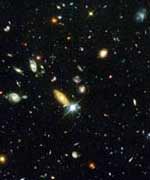
Image credit: Hubble
Physicists from Northeastern University believe that a fundamental force of nature, the bond between electrons and protons, has been strengthening since the Big Bang. In fact, they believe it might have been 200,000 times weaker ten billion years ago – and this could mirror the discovery that the Universe seems to be accelerating apart. They’ve based their research on the light from quasars ten billion light-years away. This theory is very controversial; however, as another experiment has demonstrated that the strength of the bond hasn’t changed in at least two billion years.
In this topsy-turvy world of changing trends and stormy alliances, two Northeastern University scientists propose an answer to why even the fundamental constants of nature don’t seem constant anymore. The bond between electrons and protons, called the fine structure constant, or alpha, may not be constant and may have been 200,000 times weaker about ten billion years ago. This is a recent astronomy finding that is hotly debated because it departs from the standard model of physics and may point to modifications introduced by string theory — the modern “Theory of Everything” which attempts to unify all forces in nature.
According to Drs. Luis Anchordoqui and Haim Goldberg of the Department of Physics at Northeastern University in Boston, Mass., this apparent tiny change in alpha through the years may mirror the apparent accelerating expansion rate of the Universe, as if electrons and protons clung ever more tightly together as the Universe began to fly apart. The scientists describe this process in a recent issue of Physical Review D: Vol. 68, 083513 (2003).
“The apparent change in the fine structure constant remains controversial, partly because it stands in contrast to standard field theory, the basis of all the successes in atomic and nuclear physics, in which this constant is an unvarying input to all calculations,” said Anchordoqui. “We find, however, that the apparent change agrees with a variety of different types of observations.”
Light signals from exceedingly bright and distant galaxies called quasars seem to indicate that the bond between electrons and protons was weaker in the early universe. Light left these galaxies about 10 billion years ago and thus reflects the state of matter (and the laws of nature) from that epoch. This apparent change in the fine structure constant has been observed in several independent measurements.
On Earth, however, studies of a natural nuclear fission reactor which operated in Gabon two billion years ago reveal no change in the fine structure constant, down to an accuracy of one part in ten million. Thus, if the fine structure constant has changed, it did not do so evenly through the years. Anchordoqui and Goldberg attempt to reconcile this discrepancy.
They propose that the apparent change in the fine structure constant is coupled to “quintessence.” This is a theory of dark energy in which a mysterious universal repulsive force, once weaker long ago, now dominates over the force of gravity and is causing the universe to fly apart at a never-expanding rate. Anchordoqui and Goldberg worked with one particular model of quintessence proposed by Drs. Andreas Albrecht and Constantinos Skordis of the University of California, Davis, in 2000. They found that their own theory of the fine structure constant, when viewed in the context of this quintessence model, provides agreement between the quasar data and the Gabon data.
That is, the fine structure constant was measurably weaker ten billion years ago, but as quintessence assumed dominance about eight billion years ago, the force between electrons and protons became stronger and “more constant.”
The strength of the electron-proton bond from any matter created anytime within the last several billion years is essentially indistinguishable.
The reason for this lies in the peculiar behavior of the Albrecht-Skordis model, in which the quintessence field has all but ceased its variation during the present era. The model is also consistent with landmark data collected by the NASA Wilkinson Microwave Anisotropy Probe, which has determined fundamental properties of the universe, such as its age and shape, an announcement made in February 2003. Anchordoqui and Goldberg said analyzing the light from even more distant quasars will reveal a steady decrease in electron-proton binding strength.
Also, they said their theory could be tested soon with just a ten-fold improvement in sensitivity in measuring the acceleration of different objects in free fall. This is because a variation in the fine structure constant would imply a variation of this type of acceleration as the chemical makeup varied, a violation in the equivalence principle introduced by Albert Einstein in his general theory of relativity. Two proposed space-based mission will have this sensitivity: the MICROSCOPE mission from France’s Centre National d’Etudes Spatiales, expected to fly in 2005; and a NASA-ESA mission called STEP, Satellite Test of the Equivalence Principle. “We may be able to test this model of a ‘changing’ fine structure constant within a couple of years with instruments on satellites,” said Goldberg. “Or, we could continue observing alpha in lab experiments for another several billion years to see changes on the order of the quasar values. I’m counting on the satellites.” For more information, refer to Anchordoqui and Goldberg’s journal article, “Time Variations of the Fine Structure Constant Driven by Quintessence,” available at http://arXiv.org/abs/hep-ph/0306084.
Original Source: Northeastern University
Pluto Mission Will Study Jupiter Too
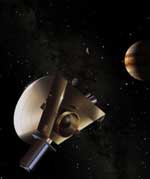
Image credit: SWRI
Although the main goal of the NASA’s New Horizons mission will be to send a spacecraft to Pluto, the mission designers figure they can examine Jupiter on the way out as well – and get a valuable gravity boost that would shave years off the mission. If all goes as planned, New Horizons would launch in 2006, and pass Jupiter in early 2007 (probably three times closer than Cassini did in 2000); it will reach the Pluto-Charon system in 2015. After Pluto, New Horizons would then be re-targeted to fly past a Kuiper Belt Object.
The main goal of NASA’s New Horizons mission may be to explore Pluto-Charon and the Kuiper belt beginning in 2015, but first the mission plans to fly by the solar system’s largest planet, Jupiter, during February-March 2007. The Jupiter flyby would be used by New Horizons to provide a gravitational assist that shaves years off the trip time to Pluto-Charon and the Kuiper belt.
During the flyby, plans call for New Horizons to use its instrument payload, consisting of cameras, spectrometers, radiometers, and space plasma and dust sensors, to make a variety of scientific observations. Toward that end, the New Horizons team has formally kicked off its planning of the Jupiter flyby science observations. Southwest Research Institute? (SwRI?) and the Johns Hopkins University Applied Physics Laboratory (APL) lead the mission. Major partners include Ball Aerospace, Lockheed-Martin, Boeing, NASA Goddard Space Flight Center and the California Institute of Technology Jet Propulsion Laboratory.
“Every spacecraft must check out its instruments and pointing capabilities in flight prior to reaching its target,” says mission project scientist Dr. Hal Weaver of the Johns Hopkins University Applied Physics Laboratory. “By virtue of the gravity assist maneuver at Jupiter, New Horizons has a unique opportunity to do its check out on a very worthy and exciting scientific target.”
“New Horizons presents NASA’s next opportunity to study the complex and fascinating Jupiter system,” says Dr. Alan Stern, principal investigator of the New Horizons mission and director of the SwRI Space Studies Department. “To accomplish its gravity-assist maneuver on the way to Pluto-Charon, our spacecraft will venture at least three times closer to Jupiter than the Cassini spacecraft did in late 2000 when it used Jupiter for a gravity assist on the way to Saturn.
“Astronomically speaking, we will fly just outside of the edge of Jupiter’s large, planet-sized Galilean moon, Callisto.” From its closer range, New Horizons will perform a number of Jupiter system studies not possible from Cassini’s greater flyby distance.
Science planning is going forward to ready the mission for its planned 2006 launch, at the same time that required environmental and safety reviews are also being done. Through the summer of 2004, the New Horizons science team will prioritize its Jupiter science activities from objectives provided by team members as well as interested scientists from around the world. To accomplish this objective, Stern has appointed mission co-investigator and imaging team lead Dr. Jeff Moore of the NASA Ames Research Center to lead the New Horizons Jupiter Encounter Sequencing Team (JEST).
“New Horizons will be the next mission to Jupiter, and it is carrying a sophisticated instrument complement,” says Moore. “We intend to cull and then schedule the most critical needs for scientific observations of Jupiter, its satellites, its magnetosphere and its rings.
“Following that,” Moore continued, “the mission team will design and implement a five-month-long sequence of observations of the Jupiter system to be made from late 2006 through early 2007 as the spacecraft approaches and then recedes from Jupiter.”
“Exploring the Jupiter system is a coveted scientific bonus for New Horizons,” adds Weaver. “It also provides us with a valuable opportunity to check out the instrument payload and many of the flyby procedures we will later use at Pluto-Charon.”
New Horizons is proceeding toward a January 2006 launch, with a planned arrival at Pluto and its moon, Charon, in the summer of 2015. The 465-kilogram (1,025-pound) spacecraft will characterize the global geology and geomorphology of Pluto and Charon, map the surface compositions and temperatures of these worlds, and study Pluto’s atmospheric composition and structure. It will then visit one or more of the icy, primordial bodies in the Kuiper belt where it will make similar investigations.
In July 2002, the National Research Council’s Decadal Survey for Planetary Science ranked the reconnaissance of Pluto-Charon and the Kuiper belt as its highest priority for a new start mission in planetary science, citing the fundamental scientific importance of these bodies to advancing understanding of our solar system.
Original Source: SWRI News Release
